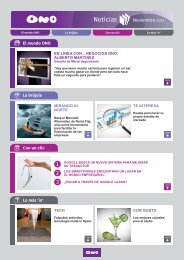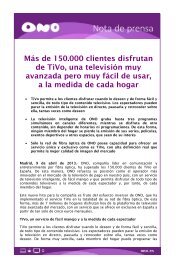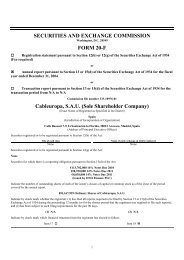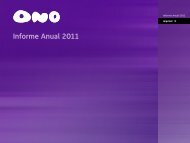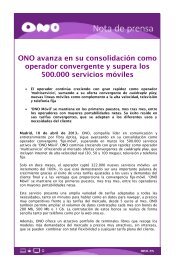Annual Report 2012 - Ono
Annual Report 2012 - Ono
Annual Report 2012 - Ono
Create successful ePaper yourself
Turn your PDF publications into a flip-book with our unique Google optimized e-Paper software.
What does ONO do?<br />
ONO’s network<br />
Access Networks<br />
The access networks are characterised by<br />
their extensive coverage and high level of<br />
reach. The Hybrid Fibre-Cable FTTN (Fibre<br />
to the Node) access network covers all<br />
the main Spanish cities, a total of over<br />
300 municipalities, with access to over 7<br />
million homes.<br />
The primary node is the main node from<br />
which the network is distributed over a<br />
specific urban area or region, covering<br />
between 10,000 and 60,000 homes.<br />
This node houses the head end for the<br />
data services that establish bidirectional<br />
communication sessions with the cable<br />
modems of users, using the DOCSIS 1.1 or<br />
3.0 protocols, and is where the aggregation<br />
is made of data services with audiovisual<br />
services (digital TV, PPV and VoD) over<br />
fibre. Telephony services can be delivered<br />
in the traditional manner, from a POTS and<br />
ISDN services multiplexer using a copper<br />
pair network, or using IP over coaxial fibre,<br />
using the Packetcable protocol.<br />
(Multimedia Terminal Adapter) which<br />
serves as a converter for VoIP-traditional<br />
telephony.<br />
The high capacity of the HFC access network,<br />
based on the roll-out of fibre optic cable to<br />
very close to the home, enables a wide range<br />
of digital communication and entertainment<br />
services, including both Triple Play services<br />
(Voice, Television and high capacity Internet)<br />
to residential customers, and advanced ASP<br />
and end-to-end connectivity services for<br />
business customers and other operators.<br />
ONO has successfully implemented the<br />
DOCSIS 3.0 standard in all the head ends of<br />
its access network, completing the rollout<br />
to 100% of the network, including the<br />
Canary Islands, in <strong>2012</strong>. The technology<br />
is compatible with previous versions of<br />
the DOCSIS protocol and eliminates the<br />
traditional speed limits of capacity on<br />
just one carrier. This new standard has<br />
facilitated a new universe of services with<br />
speeds of 30, 50 and 100 Mbps, which has<br />
enabled a rise in the number of subscribers<br />
to these speeds to now represent 50% of<br />
ONO’s total broadband customer base. It<br />
has also allowed ONO to launch a premium<br />
200 Mb service for SMEs.<br />
As a complement to the FTTN-HFC network,<br />
and in order to increase the reach of its<br />
access network, ONO has unbundled the<br />
local loop in 132 telephone exchanges to<br />
provide services based on xDSL technology.<br />
Using this xDSL access network, ONO<br />
provides connectivity with the ONO network<br />
to 134,000 lines, mainly in Madrid and<br />
Barcelona.<br />
ONO in <strong>2012</strong><br />
Who is ONO?<br />
What does ONO do?<br />
Products and services<br />
ONO’s network<br />
Investment<br />
Innovation<br />
ONO’s<br />
Responsibility<br />
Financial analysis<br />
Corporate<br />
Governance <strong>Report</strong><br />
The Figures<br />
Annexes<br />
Contact<br />
Information<br />
In the final node (FN) the optical signals are<br />
converted into electronic signals that are<br />
distributed along coaxial cable buses which<br />
connect various homes.<br />
In the client’s home, Internet services,<br />
which terminate on the cable modem,<br />
are separated from TV and VoD services,<br />
which terminate on a set top box<br />
decoder. Voice services are obtained<br />
from the copper pair or from an MTA<br />
Fibre<br />
ADSL<br />
Print<br />
<strong>Report</strong><br />
The Figures<br />
40





